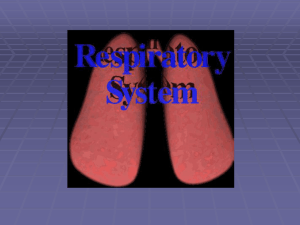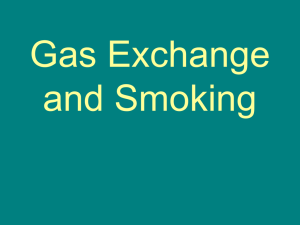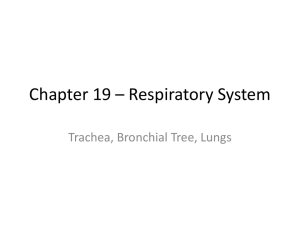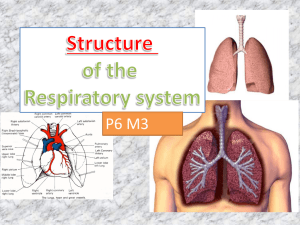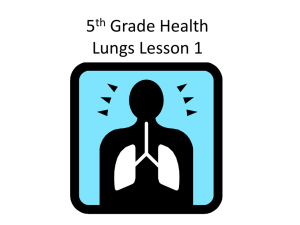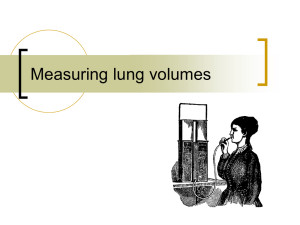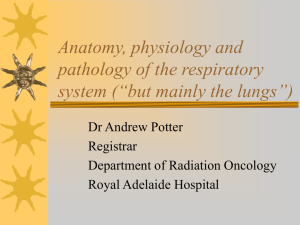Tidal volume
advertisement
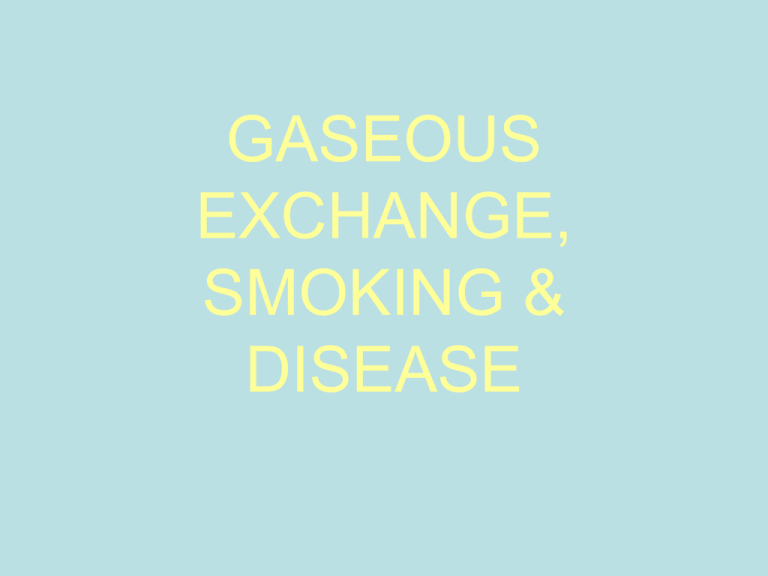
GASEOUS EXCHANGE, SMOKING & DISEASE GASEOUS EXCHANGE, SMOKING & DISEASE By the end of this chapter you should be able to : 1. Describe the structure of the human gas exchange system, including the microscopic structure of the walls of the trachea, bronchioles and alveoli with their associated blood vessels 2. Describe the distribution of cartilage, ciliated epithelium, goblet cells and smooth muscle in the trachea, bronchi and bronchioles 3. Describe the functions of cartilage, cilia, goblet cells, smooth muscle and elastic fibres in the gas exchange system; 4. Describe the process of gas exchange between air in the alveoli and the blood; 5. Explain the terms tidal volume and vital capacity; 6. Describe the effects of tar and carcinogens in tobacco smoke on the gas exchange system; 7. Describe the signs and symptoms of emphysema, chronic bronchitis and lung cancer; 8. Describe the effects of nicotine and carbon monoxide on the cardiovascular system with reference to atherosclerosis, coronary heart disease and strokes; 9. Evaluate the epidemiological and experimental evidence linking cigarette smoking to disease and early death; 10. Discuss the problems of cardiovascular disease and the ways in which smoking may affect the risk of developing cardiovascular disease; 11. Use the knowledge gained in this section in new situations or to solve related problems. Features of gas exchange surface: 1. Large surface area this increased surface area allows the diffusion of increased volumes of oxygen, required by larger animals and those with high levels of activity. 2. Moist. Oxygen and carbon dioxide can only diffuse across membranes permeable to water. Therefore all gas exchange surfaces are moist. 3. Thin membrane. Gas exchange surfaces are thin so that diffusion is efficient. The thinner the membrane, the faster the rate of diffusion. 4. Permeable. Only membrane that are permeable to water and therefore gases can be used; waterproof surfaces are not permeable to gases. 5. Transport system. Transport system ensures a partial pressure gradient exists, in mammals, between the air and the blood in the alveoli. 6. A respiratory pigment. Haemoglobin increases the uptake of oxygen. 7. Ventilation mechanisms. In humans, ventilation is called breathing. The gaseous exchange system links the circulatory system with the atmosphere. It is adapted to : 1. Clean and warm the air that enters during breathing 2. Maximise the surface area for diffusion of oxygen and carbondioxide between the blood and atmosphere 3. Minimise the distance for this diffusion 4. Maintain adequate gradients for this diffusion Structure Involved : 1. The structure involved are the breathing system consisting the trachea, bronchi, branchioles and alveoli 2. The trachea or windpipe connects the larynx with two bronchi that lead into the lungs 3. The trachea kept hollow by U-shape cartilages for easy passage of air. The innermost layer is lined by pseudostratified epithelium, which has cilia and mucus secreting cells. Mucus is produced by the goblet cells of the ciliated epithelium. 4. Each bronchus has the same structure as the trachea and branches to form a ‘tree’ of bronchioles, which also has ciliated, mucus secreting epithelium but no cartilage 5. Each bronchiole ends with an alveolar sac, which is surrounded by network of capillaries 6. Both alveoli and capillaries have thin simple squamous epithelia to facilitate diffusion of gases across them with least resistance. Thus, the air in the alveoli and the blood is hardly 1 µm away cont…. Structure Involved : cont … 7. The walls of the alveoli have elastic fibres that stretch during breathing and recoil during expiration to help force out the air. This helps to maintain the pressure potential between the gases inside the alveoli and those within the blood. 8. The total surface area of the alveoli in human is around 100 square meters, the size of a tennis court. The total volume of air that can get into the alveoli of a young man averages 4,6 liters and another 1,5 liters found in the trachea, bronchus and bronchioles where no gaseous exchange occurs. 9. Phagocytotic white blood cells known as macrophage patrol the surfaces of the alveoli and entire air passages to rid them of fine dust particles and bacteria especially during infection. 17% O2 4% CO2 Blood flows out 21% O2 0,04% CO2 ALVEOLUS O2 CO2 Red blood cell The process of gaseous exchange in the alveolus Blood flows in Thin alveolar wall Capillary Thin endothelium Lung Volumes and Capacities 1. At rest we need to ventilate our lungs with about 6,0 dm3 of air per minute. 2. Tidal volume (0,5 dm3) is the volume of air that is breathed in and out by man at rest. The volume is about 500 cm3. 3. Inspiratory reserve volume (3,1 dm3) is the extra volume of air taken in voluntarily after the normal inhalation. 4. Expiratory reserve volume (1,2 dm3) is the volume of air that can be further breathed our after the normal exhalation. 5. Vital capacity (4,8 dm3) is the volume of air breathed our after a forced inspiration followed by a forced expiration. This about 4,800 cm3 for normal people but athletes have higher vital capacity through training. 6. Residual volume (1,2 dm3) is the volume of air still left in the lung after a maximal forced expiration. This residual volume includes the air left in the trachea, bronchi and bronchioles, which cannot be contracted to expel the air. 7. Total lung capacity (6 dm3) is the maximum volume of air in the lung after forced inhalation. This is same as the vital capacity plus the residual volume. Ventilation Rate : this is the total volume of air moved into the lungs in one minute. Ventilation rate (expressed as dm3/min) is calculated as : tidal volume x breathing rate CO2 and O2 Distribution CO2 and O2 Transportation Haemoglobin Dissociation Curve Breath Rate and Heart Rate Control SMOKING AND DISEASE TOBACCO SMOKE 1. There are over 4000 different chemicals in cigarette, many of which are toxic. 2. Three main components of cigarette smoke pose a threat to human health, damaging in particular either the gaseous exchange or cardiovascular system. 3. Tar, settles on the lining of the airways in the lungs cancer 4. Carbon monoxide, combines with Hb carboxyhaemoglobin, 250 times more readily than it does with oxygen 5. Nicotine is the drug in tobacco LUNG DISEASE 1. Chronic bronchitis high infection 2. Ephysema : alveolar burst: high infection smaller quantities of elastin 3. Chronic obstructive pulmonary disease : refers to the overall condition, which is a progressively disabling disease. - rare in non-smoker - 90% of people deaths from chronic obstructive disease are attributed to smoking - 98% of people with emphysema are smoker - 20% of smokers suffer from emphysema - deaths from pneumonia and influenza are twice as high among smokers. 4. Lung cancer tar carcinogen cancer - smokers are 18 times more likely to develop lung cancer than non-smokers - 1/3 of all cancer deaths are a direct result of cigarette smoking - 25% of smokers die of lung cancer Emphysema Atherosclerosis CARDIOVASCULAR DISEASE 1. Atherosclerosis : accumulation of fatty material in artery wall - this build-up of atheroma, which contain cholesterol, fibers, dead muscle cell and platelets, is termed atherosclerosis - cholesterol is insoluble in water and so transported in the blood plasma in tiny balls of lipid and protein called Lipoproteins : a. LDL (Low Density Lipoprotein) bad b. HDL (High Density Lipoprotein) good 2. Coronary Heart Disease : Atherosclerosis at the coronary artery. There are 3 form : a. Angina pectoris severe chest pain b. Heart attack / myocardial infraction, large branch of coronary is obstructed by a blood clot c. Heart Failure due to blockage of a main coronary artery 3. Stroke - stroke occurs when an artery in the brain burst so that blood leaks into brain tissue or the artery is blocked by plaques - the brain tissue is starved of oxygen and dies - a stroke may be fatal or cause mild or severe disability - as a result of a stroke, some people are unable to control part of their body; others may lose their ability to speak or some or their memory

